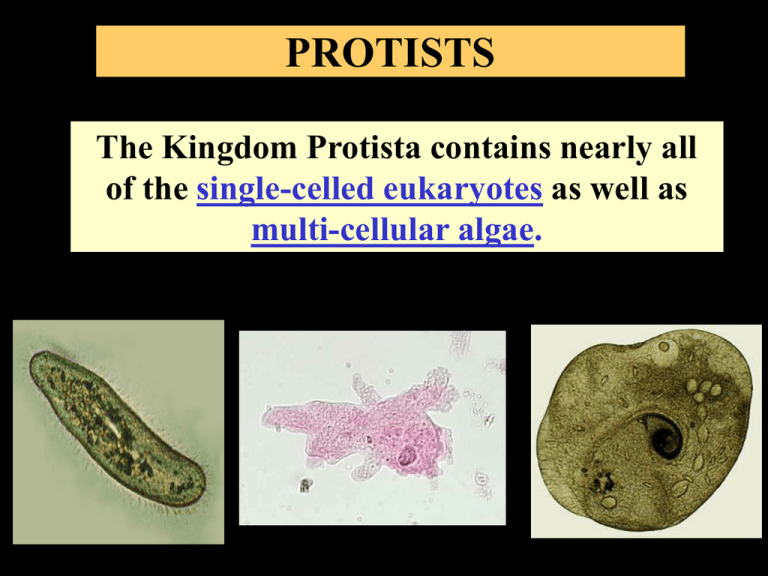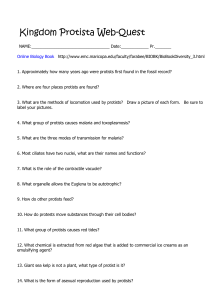protists - nimitz163
advertisement

PROTISTS The Kingdom Protista contains nearly all of the single-celled eukaryotes as well as multi-cellular algae. Protists Have Complex Cells Protists have a nucleus which contains chromosomes. Membrane-bound organelles, such as chloroplasts and mitochondria, are found in the cell’s cytoplasm. Chloroplasts occur in autotrophic protists. Most protists are either autotrophic or heterotrophic, though Euglena is both. Many Protists Are Capable of Movement •Cilia and Flagella are hair-like projections that produce movement and consist of similar internal microtubule structures. •Euglena swim about powered by a flagellum, that lashes back and forth like a whip. Cilia video clip (.39) Flagellates video clip (.50) Paramecium are covered with thousands of tiny hair-like projections called cilia, that beat back and forth like miniature boat oars to propel it forward or backward. Amoeba move and feed using fingerlike, flowing extensions of the cell body called pseudopods or “false feet.” Classification of Protists • The members of the Kingdom Protista exhibit a greater variety of sizes and structures than do the members of any other kingdom. • Because of the diversity in the Kingdom Protista, biologists disagree on how many phyla it should contain. Algae •Most species of algae live in fresh water or salt water, although they can also be found in moist soil, on damp rocks, and on the shady sides of trees. •Algae produce about 1/3 of the oxygen in the atmosphere. •They form the base of the aquatic food web (fishes, whales, and humans depend on algae for the food they eat and the air they breathe). Heterotrophic Protists •Most heterotrophic protists play the role of either carnivore or herbivore. •In the plankton, some heterotrophic protists “graze” on phytoplankton, and others prey on these grazers. •Other heterotrophic protists are parasites or decomposers. Diseases Caused By Protists In central Africa, a protist transmitted by the bite of a large fly, the tsetse fly, causes the disease sleeping sickness. This disease is often fatal to humans and domestic animals such as cattle, sheep, and pigs. Livestock cannot be raised in much of central Africa because of the presence of sleeping sickness. Protists and Disease Many protists do not affect the health of human beings. However, millions of people are infected by and die from various protist-caused diseases each year. Disease-causing protists are transmitted mainly by insects and contaminated water. Malaria •Currently, 300 million to 500 million people are infected with malaria. •This disease kills more than 2 million people each year, making it one of the most serious human diseases. •Malaria is the leading cause of death among young children in tropical countries. •Malaria is caused by protozoa of the genus Plasmodium, which is carried between human hosts and mosquitoes. •Symptoms of malaria are high fever, delirium, and sweating. Severe chills follow the fever and can last until the next outbreak. •Malaria sometimes weakens its victims so much that they die from other infections. •The drastic loss of blood cells (up to 40%) causes anemia and can result in fatal brain or kidney damage. •Quinine was used in the 1600s to reduce the symptoms. Derivatives such as chloroquine and primaquine are used today to treat and prevent malaria. p. 367 Malaria Vaccine Dr. Manuel Patarroyo, a Colombian biochemist and physician, has developed an unorthodox, synthetic malaria vaccine called SPf66. This vaccine is made from malaria proteins chemically linked together. The antibodies that it includes recognize the real malaria parasites rather than just the vaccine’s synthetic proteins. Trials have shown that the vaccine offers some amount of prevention against malaria infections, including those carried by the drug-resistant parasites. At first, scientists were skeptical about the vaccine because it originated from research in a small country and its preparation was unusual. However, the World Health Organization is calling for further research. Malaria Strikes Back Malaria has not been eliminated. •The number of cases has been increasing since the mid-1970s. •Human efforts have been thwarted by advances in the parasite and the mosquito. •The parasite frequently changes configurations (mutation), making them invisible to the body’s immune system. •Parasites have also developed resistance to some of the drugs. •Mosquitoes have evolved resistance to insecticides. Human Diseases Caused By Protists Disease Host Organism Amoebic dysentery Humans Entamoeba Malaria Humans Plasmodium Toxoplasmosis Humans, cats Toxoplasma Giardiasis Humans Giardia Sleeping Sickness Humans, tsetse Trypanosoma flies Chagas’ disease Humans, kissing bugs Trypanosoma Leishmaniasis Humans, sand flies Leishmania




